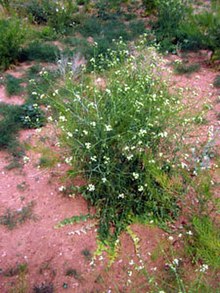Sisymbrium altissimum
| Sisymbrium altissimum | |
|---|---|
 |
|
| Scientific classification | |
| Kingdom: | Plantae |
| (unranked): | Angiosperms |
| (unranked): | Eudicots |
| (unranked): | Rosids |
| Order: | Brassicales |
| Family: | Brassicaceae |
| Genus: | Sisymbrium |
| Species: | S. altissimum |
| Binomial name | |
|
Sisymbrium altissimum L. |
|
Sisymbrium altissimum is a species of Sisymbrium. The plant is native to the western part of the Mediterranean Basin in Europe and Northern Africa and is widely naturalized throughout most of the world, including all of North America. It was probably introduced into North America by a contaminant crop seed. The plant grows in soils of all , even sand. The plant germinates in winter or early spring. The blooming time is lengthy, and after maturity the plant forms a tumbleweed. Common names of the plant include Jim Hill mustard, after James J. Hill, a Canadian-American railroad magnate,tall tumblemustard,tall mustard, tumble mustard,tumbleweed mustard, tall sisymbrium, and tall hedge mustard.
Tumble mustard forms a tall (up to 5 ft) but delicate-looking plant, with slender, much-branched stems. Its stem leaves are divided into thin, linear lobes, while the basal leaves are broader and pinnately compound. The flowers are inconspicuous and only 1/4 inch wide. They have four usually yellow petals and four narrow, curved sepals. The seedpods are slender and long (2-4 inches). At maturity it dies, uproots, and tumbles in the wind, spreading its seeds.
...
Wikipedia
